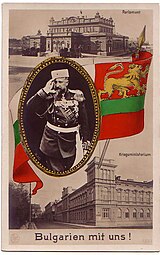|
Second Battle of Cobadin
The Second Battle of Cobadin took place from 19 to 25 October 1916 between the Central Powers, chiefly the Bulgarian Third Army, and the Entente, represented by the Russo–Romanian Dobruja Army. The battle ended in a decisive victory for the Central Powers; it resulted in the occupation of the strategic port of Constanța and the capture of the railway between that city and Cernavodă. The battleThe Romanian Second Army, led by major general Alexandru Averescu, fielded the following units:
The Russian Dobruja Army, led by general Andrei Zayonchkovski, comprised the 47th Army Corps. Its main components were:
The Bulgarian Third Army, led by lieutenant general Stefan Toshev, comprised the following units:
AftermathBattle of the Danube DeltaDespite the loss of most of Dobruja to the Central Powers, the Romanian defensive victory at Tulcea in January 1917, combined with the actions of the Romanian cruiser Elisabeta at the mouths of the Danube, ensured Romanian control over the entire Danube Delta throughout the rest of the War.[5] See alsoReferences
Sources
|
||||||||||||||||||||||||||||||


